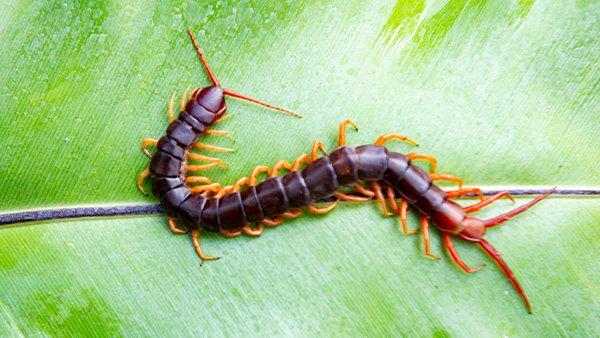Here in Texas, we’ve got a plethora of centipede species, from the massive scolopendra heros – or the giant redheaded centipede – to the tiny (but still creepy looking) house centipede. While centipedes aren’t a serious threat to your life or health, they still pack an intensely painful venom that can sometimes hurt worse than a bee sting. The bigger the centipede, the more painful its bite. Let’s talk about how to keep these ugly, venomous pests away from you.
A Hundred Legs, A Hundred Problems
While their name literally means “a hundred feet,” no centipede has 100 feet. Since, centipedes always have an odd number of pairs of legs, it’s impossible for them to have exactly 100 legs. What they do have is one pair of legs per body segment. Depending on their size and number of segments, they can have as few as 30 legs to as many as 350 plus. That’s a lot of legs!
In addition to their dozens of legs, all centipedes have an elongated and segmented body, a round or flattened head with a pair of antennae and oversized mandibles, and two sets of maxillae – or mouthparts. They also have an overlong pair of forelimbs tipped with sharp claws that inject venom. That means the centipede doesn’t technically bite, but because it injects its venom from glands so close to the mouthparts, most people just call the sting it inflicts a “bite.”
Centipedes can range in size from about half an inch long to nearly a foot in length. Here in Texas, the giant redheaded centipede can reach lengths of eight or nine inches and feed on things like lizards, snakes, toads, and even small rodents!
Why Centipedes Invade Your Home
Most centipede species prefer to remain outside, but you might find them in your house for several reasons. First off, centipedes like to hang out in places with lots of moisture, so if your house has issues like leaky plumbing or there is a drought going on, they might come in seeking water.
Centipedes are also predators, so if you have an infestation of their favorite prey (such as cockroaches, silverfish, and the like), they might come into your home after these prey items. Finally, if the spring weather turns cold after they’ve emerged from their winter shelters, they could be attracted to your home’s warmth.
Centipede Prevention
While a smattering of centipedes in the backyard can help cut down on roaches and other creepy pests, you still don’t want a houseful of these stinging arthropods. Fortunately, there are a few things you can do to keep them out of your house, such as:
- Fix moisture issues like clogged gutters and leaky plumbing.
- Clear out leaf litter and other clutter in your yard that could provide moist hiding places.
- Get rid of other infestations that could be attracting centipedes (like roaches or spiders).
- Inspect your house and ensure there are as few centipede entry points as possible.
- Make sure window screens are intact and door sweeps are sealed with weather stripping.
Unfortunately, even these prevention measures don’t always get the job done. Luckily, there’s professional help. Here at All-Safe Pest & Termite, we’ve got the experience and tools to help you put these pests to rest. Our home pest control protection plans are fast, effective, eco-friendly, and they start as low as $29.99! With value like that, there’s no reason to fight a centipede (or any other) infestation on your own. So give us a call at (972) 945-9226. You can also visit our contact page to schedule your service.



